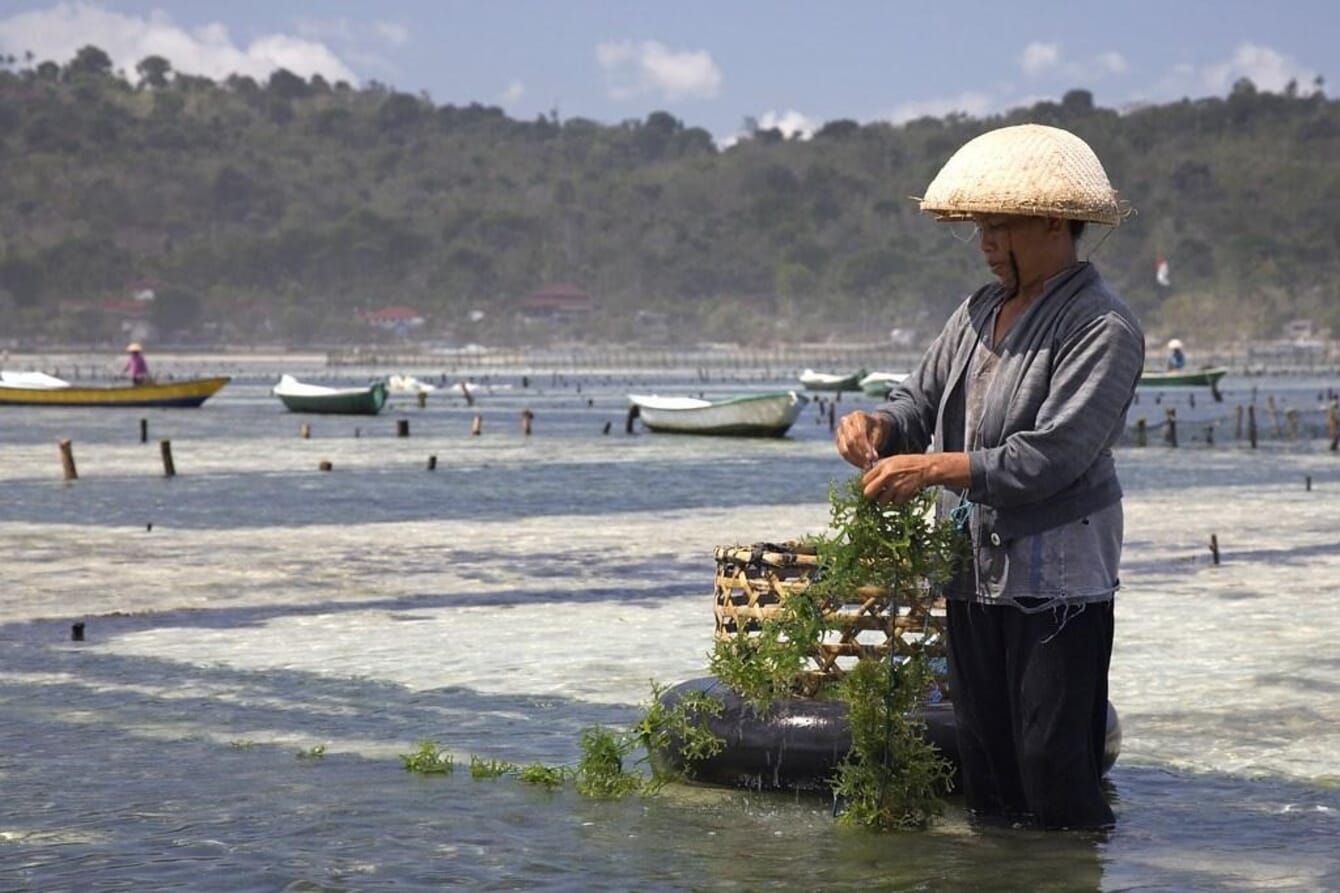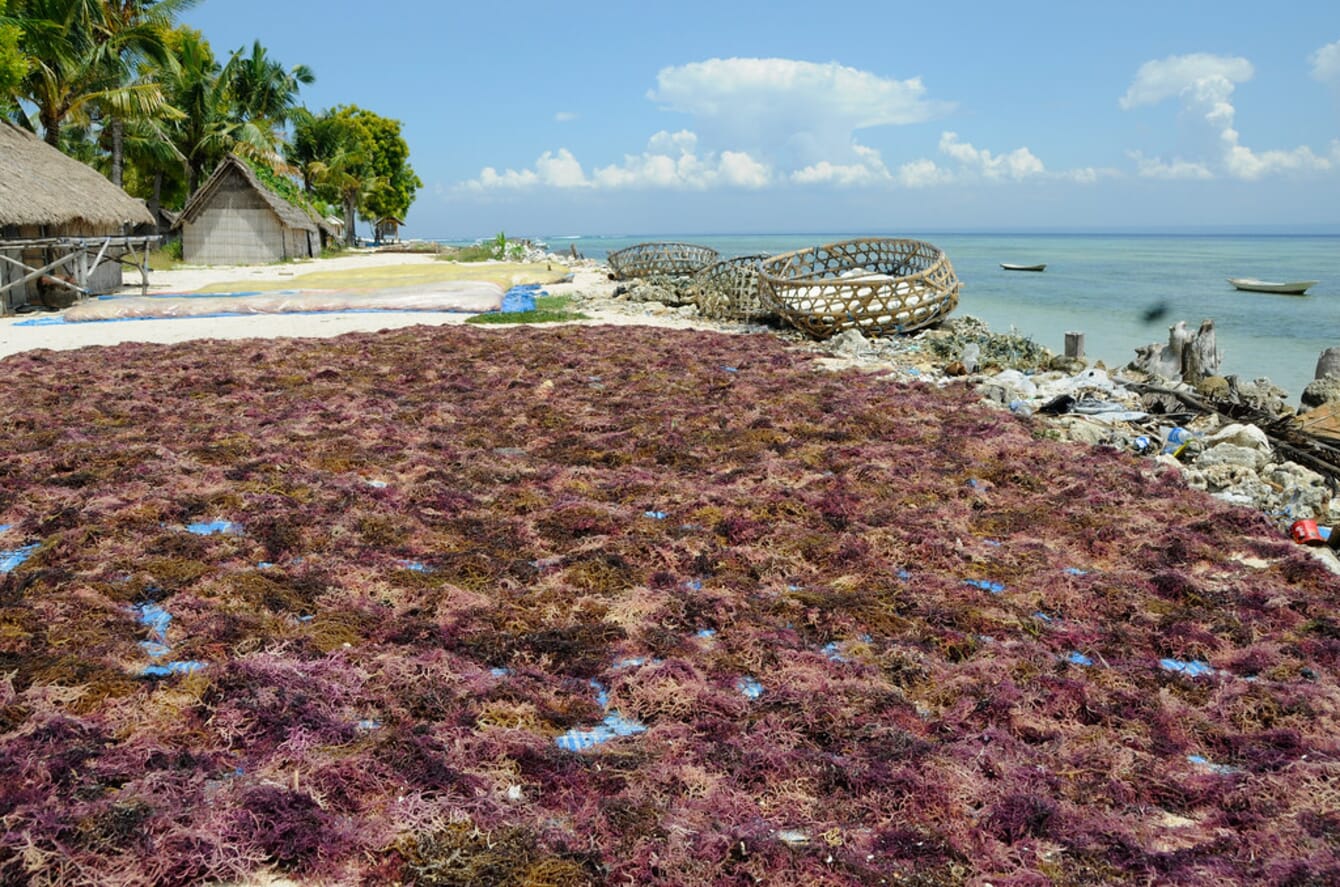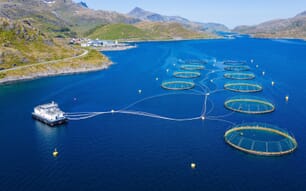
© JM Hullot
The economic landscape in Bali, Indonesia, has changed dramatically since March last year when Covid-19 and associated lockdowns disrupted tourist arrivals. In 2018, 80 percent of Bali’s economy was based on tourism, as arrivals had been steadily increasing each year since 2011. While 2019 saw 6.28 million tourists visiting the island, the pandemic resulted in only 1.05 million arrivals in 2020, leaving many previously employed in the tourism sector out of work.
In recent weeks, international news outlets have presented the return of some Balinese to seaweed farming as a potential turning point for the island’s workforce – an opportunity to dilute an overreliance on foreign tourism and, in the process, alleviate some of the negative environmental externalities that tourism development has contributed. Media outlets have touted the “rediscovery” of seaweed farming, with one describing it as “The Great Reboot”, and the Australian ABC Network’s Foreign Correspondent dedicating an episode to the economic pivot, claiming “an old way of life has returned”.
But while people in Indonesia have collected seaweeds and ocean flora for centuries, seaweed farming, as it is practiced today, was only introduced to Bali in the early 1980s, and has been heavily concentrated in the island’s southern waters. Experts say that, while it’s inaccurate to present seaweed farming as a traditional way of life to be preserved, since it was introduced the practice has brought about positive economic outcomes. Despite these benefits, seaweed cultivation’s sustainability and suitability as a viable long-term livelihood alternative for many Balinese is impacted by access limitations, supply chain obstacles, and evolving socio-environmental dynamics.
Bali’s tourism trajectory
That an overreliance on tourism has characterised Bali’s economy for some decades is neither a contested fact, nor an accident. Indonesia’s 2011 Masterplan for Acceleration and Expansion of Indonesian Economic Development set out a detailed trajectory for the country’s development aspirations by the year 2025: the Bali-Nusa Tenggara Economic Corridor, which Bali falls within, was to focus developmentally on tourism and food production to promote economic growth.
While the economic success of tourism in Bali is paradoxically dependent on the environmental integrity of the island, the acceleration of what has been described as the “dizzying pace of tourism development, land alienation, and ecological degradation” has disproportionately placed the negative environmental externalities of a largely foreign-owned tourism industry on the Balinese people. A 2015 study found that, while those employed in tourism made up 25 percent of the workforce, 85 percent of the industry is non-Balinese owned. The industry accounts for 65 percent of Bali’s water consumption, and environmental costs have been particularly pronounced for the surrounding oceans, rivers and waterways, which have been affected by large amounts of plastic waste, development runoff and marine traffic.

© Joel de Vriend, Unsplash
The ebbs and flows of seaweed farming in Bali
Since its introduction in the early 1980s, most seaweed farming in Bali has occurred in the Nusa Dua region and across the Badung strait – the 12 km long narrow sea strip that separates the mainland from the southern islands of Nusa Penida, Nusa Lembongan and Nusa Ceningan, which fall within Bali’s Klungkung regency and where conditions are uniquely suited to farming certain seaweed species.
As marine biologist and director of PT Sea Six Indonesia Iain Neish tells The Fish Site, “[These areas] are unusual – they’re shallow reef flats enclosed with a beach on one side and a barrier reef on the other, and these are perfect places to grow seaweed. There’s great water turnover because of water sloshing over the reef and seaweed grows naturally, so it’s like they were designed for seaweed farming.”
Farming here is predominantly of carrageenophytes – a red variety of seaweed from which hydrocolloids are extracted to produce carrageenan, a product used as a thickening agent for foods in dairy products such as ice cream, condensed milk, processed cheeses, jellies, baby foods and pet foods. It is also used as a binding agent for toothpaste, as a thickener for shampoos and other cosmetic products, and air fresheners. Industrial products utilising carrageenan include abrasives, pigments, pharmaceuticals, textiles and agricultural agent solutions.
There are various scientific and trade names used to describe carrageenophytes, which in recent years have been reclassified. These include the genuses Kappaphycus and Eucheuma, which for commercial purposes are referred to as cottonii and spinosum respectively. The calm waters between the islands of Lembongan and Ceningan host a particularly ideal space for cultivation of the more economically viable cottonii species, while spinosum is grown more commonly on the northern coast of Nusa Penida.
Cultivation is carried out using traditional methods, either involving the use of rope lines that attach to stakes made of bamboo or wood, drawn out in square 10 m x 10 m square plots on the water’s surface, on the sea-bed, or on semi-submerged rafts. The seaweeds reach an ideal weight for harvesting by hand after 30 to 32 days, after which they are sun-dried until an ideal moisture content is reached. At this stage it is typically sold to middlemen, known as “collectors” for transportation to domestic or international locations to be processed. They purchase the seaweed based on a price set by the government.
Middlemen typically live in villages near seaweed farmers and can be representatives of carrageenan producers, independent institutions, or cooperatives formed by seaweed farmers. They sell the raw dried seaweed onto large traders after large quantities are collected from farmers. Independent farmers sell raw dried seaweed (RDS) to their choice of local trader to sell onwards, and these traders decide the market price. Dependent farmers sell their seaweed to specific local traders or cooperatives, and in these arrangements the farmers and traders have settled on informal agreements regarding price, which may involve the trader providing financial assistance to the farmer.
Access limitations preventing mass cultivation
The portion of the population that has access to seaweed farming as an alternative means of employment in Bali is relatively low. 90 percent of Bali’s seaweed farming areas are located in Klungkung, Bali’s smallest regency, in the island’s south. When access is available, there are strict regulatory measures that limit the size and location of seaweed farms.
Asked about issues of access, Neish says: “There are ancestral tenure privileges that have been carved up and allocated for a long time, so when farming resumed [due to the pandemic] it basically went back to the people who had been farming previously, who are mostly members of kelompok tani (farmer groups)”.
“The jurisdiction over farming falls to the village – there are severe restrictions on where you can plant and how you can plant it. In the case of Bali, they reduced the size of plots to about one are (100 square metres). Five years ago, a seaweed farmer could make good money – ten million rupiah (approximately USD $684) per month or more, but then the pie got cut up. Every farm was so small that it wasn’t really enough to make the income the family needed,” he adds.
Starting up a farm requires considerable investment and multiple people – usually a family unit – to maintain a small area, and returns on investments are slow and unreliable.
Wayan Merta Danta’s family have been seaweed farmers since the 1990s, but Wayan sought employment in tourism in 2010, when Nusa Lembongan started gaining popularity as a destination. Now, due to the pandemic, he’s returned to farming with his family.
“If you work in seaweed, you need many people, like a family. It’s not possible by yourself because it is hard work,” Wayan explains.
“You need a lot of money to start growing seaweed. When you start, for a minimum of four months you will not get money back, if it’s good seaweed. If it’s not good seaweed, it will take longer.”
Asked about whether seaweed farming offered comparable income to his previous earnings from cafe work, Wayan says that “it’s not the same, because seaweed is difficult. Like rice, sometimes seaweed is good and sometimes not good. If it’s not good, you don’t have money. If the seaweed is good, you can get money, but not much”.
David Booth, founder of the East Bali Poverty Project, echoes the sentiment that seaweed farming as an alternative income is severely limited by both geographic access to farming areas and a lack of government support for business training that would lead to adequate returns.
“Seaweed farming is an option, yes, but not everyone has access to it. It’s been happening in Nusa Penida for years, and with government support they could be flourishing industries, supporting people to develop the skills to establish their own businesses from production to licensing to processing to marketing and packaging,” he explains.
Supply chain and business development challenges
With a young population who are motivated by the modernisation that tourism has brought to the south of the island, encouraging young people to get involved in farming presents another challenge.
David Booth also emphasises that young Balinese, in particular, would benefit from the diversification of the economy and encouragement of entrepreneurship in general.
“The government needs to help by creating opportunities to establish small businesses and supporting existing small businesses. There have to be the training facilities in business ownership, so people don’t have to travel 400 km, and they have the know-how, the training, and capacity building to take advantage of what they have in their own area,” Booth says.
Last year the local government announced a desire to increase seaweed farming in Lembongan through a programme that would employ 100 farmers and designate 0.8 hectares of farming area per farmer to grow seaweed. On 29 March, Canadian Ambassador to Indonesia, Cameron MacKay, visited Nusa Penida to oversee the cooperation programme established by the Canadian and Indonesian governments to increase seaweed exports from Nusa Penida.
As the export route at present is relatively long, the market price for seaweed received by the local farmers is inadequate to serve as a viable alternative to previously earned salaries in tourism. The supply chains involve sun drying, storage, packaging, and distribution, and for farmers this also includes decisions concerning the ideal times for cultivation and harvesting, transporting and labour. Supply chain management is needed to improve efficiency and product quality from suppliers to customers and to achieve increased profitability, added value, efficiency and a competitive advantage in the sector.
While Indonesia is the largest global producer of raw dried seaweed, and the sales value of carrageenan is the world’s highest compared to other hydrocolloids, Indonesia misses out on seeing returns from the value added to the seaweed post-processing, as most Indonesian seaweeds are exported in their raw, dried form. A 2016 study showed that in Indonesia an increase in export volume led to a decrease in seaweed market price.
A study published in 2019, analysing carrageenan supply chains in Indonesia, found that global demand for and new product development of carrageenan is set to increase. But, due to the country’s sparse, archipelagic geography, manufacturing carrageenan domestically would not necessarily shorten the supply chain or reduce the cost of transportation.

© Jeda Villa Bali
Susceptibility to socio-environmental fluctuations
Seaweed farming itself is not immune to fluctuations in viability brought on by external factors. In addition to the increasing availability of lucrative work in hospitality or tourism-related construction, seaweed’s climate sensitivity and susceptibility to price fluctuations is what drove many Balinese away from the sector.
Between 2013 and 2017, seaweed farms were badly affected by a bacterial infestation caused by increased water temperatures and changes in salinity brought on by climate change, leading to significantly reduced yields and low selling prices. As a result, from 2016 to 2017, seaweed production decreased by 99 percent, from 100,856 tonnes to just 597 tonnes, and increased again slightly to 1,684 tonnes in 2018.
Experts say the seaweed farming industry in Bali could be made more resilient by expansion into the cultivation of other, more climate-resistant species of seaweed. Traditional cultivation relies on the monoculture system, but co-cultivation has been found to support increased growth. Research conducted from December 2019 to January 2020 in Pandawa on Bali’s east coast showed that the weight of cultivated seaweed was highest in co-cultured environments.
Assessing viability and opportunities for development
The current crisis is not the first recent context in which seaweed in Bali has been discussed. Previous farmers of seaweed considered returning to the practice in 2017, when Bali’s volcanic Mount Agung erupted consistently over a period of several months disrupting tourist arrivals. It has been explored as a means of addressing the island’s dire plastic pollution problem through the production of bioplastics, for its carbon sequestration, water purification, and coastal protection properties, and as an alternative livelihood to fishing amidst dwindling fish stocks. But while seaweed farming certainly holds benefits and opportunities, it falls short of promising a viable, long-term alternative income for the majority of Balinese who lack access to farming sites and a dominant position within the supply chain.
While farming may not be a long-term livelihood transition, it is presently serving as a crucial stop-gap for many located in seaweed producing regions. Though geographical limitations are relatively rigid, the existing industry could be made more economically viable, environmentally sustainable and socially equitable through support that ensures market value for existing farmers, and the encouragement of business ownership that would ensure positive environmental outcomes are accompanied by proportionate economic returns that stay in Bali.




